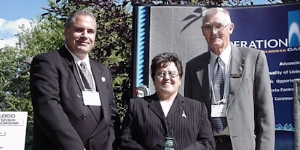
The 100,000th customer, Louise Deacon, was honoured by Federation CEO Mike Heck (left) and Federation Chairman Ken Sydnes in a ceremony at the Legislature Grounds in 2002.
|
In 2002 - 40 years after the creation of the first gas co-op! - the Federation signed up its 100,000th customer. These "customers" are, in essence, our owners, and come from every facet of rural Alberta, served with natural gas from either their local gas co-op or public municipal utility.
|